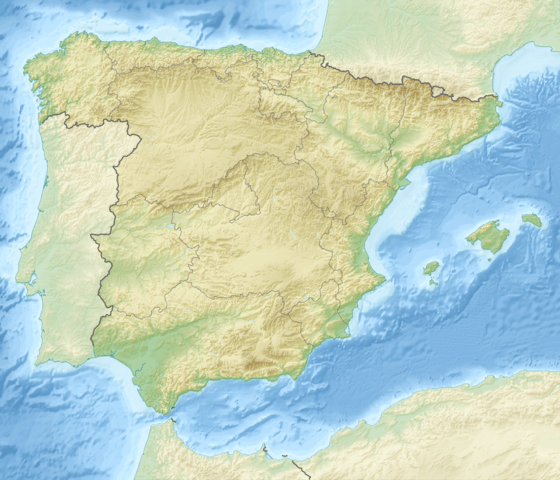Consuegra
Consuegra is a municipality located in the province of Toledo, Castile-La Mancha, Spain. In 2009 the municipality had a population of 10,932 inhabitants. It is 80 km from Ciudad Real and 60 km from Toledo. Consuegra is located in La Mancha region, famous for its extensive dry plains, vineyards and historical constructions such as windmills.
Consuegra | |
|---|---|
_(cropped).jpg) | |
 Flag  Coat of arms | |
 Consuegra  Consuegra | |
| Coordinates: 39°27′43″N 3°36′23″W | |
| Country | Spain |
| Autonomous community | Castilla–La Mancha |
| Province | Toledo |
| Government | |
| • Mayor | Benigno Casas Gómez |
| Area | |
| • Total | 358 km2 (138 sq mi) |
| Elevation | 704 m (2,310 ft) |
| Population (2018)[1] | |
| • Total | 10,098 |
| • Density | 28/km2 (73/sq mi) |
| Time zone | UTC+1 (CET) |
| • Summer (DST) | UTC+2 (CEST) |
| Website | Official website |
The principal economy sector is agriculture. The industry is predominated by textile and wood. Tourism has become a new economical source in the 21st century. The castle and the windmills are Consuegra's most important monuments.
Most Spanish windmills, like those described in Miguel de Cervantes' early 17th century novel Don Quixote, can be found in the community of Castilla-La Mancha, in central Spain. The best examples of restored Spanish windmills may be found in Consuegra where several mills spike the hill just outside town, giving a view of the 12th-century castle and of the town. Windmills are also located in Mota del Cuervo, Tomelloso, and Campo de Criptana.
History
The settlement dates back to pre-Roman times.[2] The Romans dammed the river Amarguillo upstream from Consuegra to regulate the water supply.
The castle was once a stronghold of the Knights of San Juan, the Spanish branch of the Knights Hospitaller of the Order of St. John of Jerusalem.
Main sights
Windmills

Consuegra is famous due to its windmills. They became famous in the 17th century, when Don Quixote was first published. The introduction of the windmills was made by "Caballeros Sanjuanistas", who brought these machines that helped millers. These machines used the wind to grind grain (the most common grain is wheat). The windmills were transmitted from fathers to sons. They usually consisted of two rooms or levels. Millers had to carry sacks of grains that could weigh 60 or 70 kilos to the top floor, they rotated the sails of the windmill as the top part of the windmill or dome was movable. They stopped being used at the beginning of the 1980s.
Some of the most important parts of the windmill are:
- Tunnel or canal: through it the grain goes down.
- Container: where the grain is stored
- Piece of wood: for moving the sails
All of them had names to differentiate one from another:
- Names in 1963
- La zorra
- La tuerta
- Mochilas
- Vista alegre
- Panza
- Bolero
- Santo domingo
- Chispas
- Rastrero
- Por si pega
- Bateria
- Espartero
- Blanco
- Names today
- Sin nombre
- Clavileño
- Chispas
- Espartero
- Rucio
- Cardeño
- Caballero del verde gabán
- Alcancia
- Ruinas
- Sancho
- Mambrino
- Bolero
There were 13 windmills originally, but 12 have been reconstructed.
Castle of Consuegra
The original fortress at the site was perhaps built by emperor Trajan, but historical records only recall that a fortress here was initially built by Almanzor. During the Reconquest, in times of Alfonso VIII to the Knights Hospitaller. In 1813 it was destroyed during the Peninsular War.
In 1962 the castle was ceded to the town hall and underwent a period of reconstruction. This received an impulse in 1985 with the creation of the School Workshop, whose activity continue today.
Town hall and major square
The town hall is in Renaissance style and it is located at the major square, called "Plaza de España". It was built on 1670. Joined to the townhall it is the "La torre del reloj". In this square is the building called "Los Corredores" (17th century), which is a typical structure of La Mancha and which was an old townhall.
Crafts
The crafts are a tradition of "consuegra" noted for its quality and variety. The raw materials with these products are created normally are autochthonous, and are mainly from that region.
In the city can be found workshops of classically designed items, in which there are elaborate doors, iems, and furniture for domestic use, such as chairs or bedrooms and two great workshops in stone.
Festivals
The last October weekend includes the Rose of Saffron. This festival started in 1963. It is divided into several sections: the grain of wheat in Sancho's windmill, the choosing of a "Dulcinea" by the townsfolk, and a gastronomic competition. It was created in 1962 by D. Oscar Dignoes.
Some of its important celebrations are "San Antón", Easter or its own celebrations from 20–25 September, its more distinguish celebrations are "La Fiesta de La Rosa del Azafrán" and "Consuegra Medieval".
Gastronomy
Its gastronomy is from “Machegos food or Toledo’s traditional food”, such as migas (made up by small pieces of bread with "chorizo", bacon, ham...), gachas (made of flour, "chorizo" and more ingredients), and other types of food.
References
- Municipal Register of Spain 2018. National Statistics Institute.
- Spann, P (2016), Places: 265876 (Consabura/Consabrum), retrieved 1 July 2019 – via Pleiades
_Consuegra_(cropped).jpg)